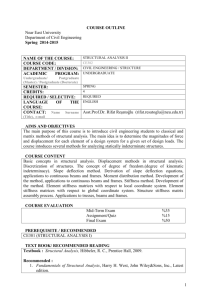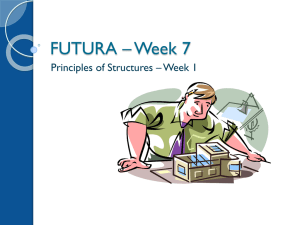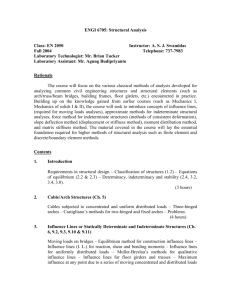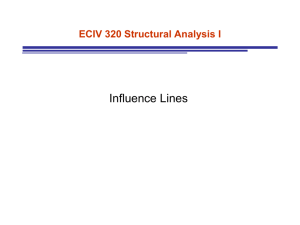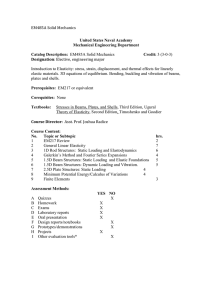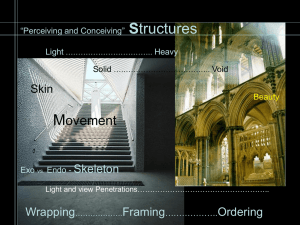I: STRUCTURAL ANALYSIS
advertisement
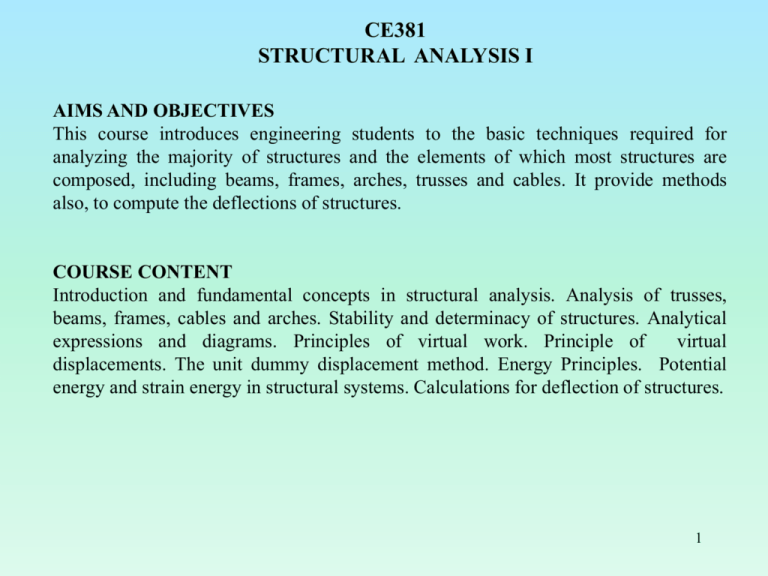
CE381 STRUCTURAL ANALYSIS I AIMS AND OBJECTIVES This course introduces engineering students to the basic techniques required for analyzing the majority of structures and the elements of which most structures are composed, including beams, frames, arches, trusses and cables. It provide methods also, to compute the deflections of structures. COURSE CONTENT Introduction and fundamental concepts in structural analysis. Analysis of trusses, beams, frames, cables and arches. Stability and determinacy of structures. Analytical expressions and diagrams. Principles of virtual work. Principle of virtual displacements. The unit dummy displacement method. Energy Principles. Potential energy and strain energy in structural systems. Calculations for deflection of structures. 1 TEXT BOOK/ RECOMMENDED READING Textbook : Structural Analysis, Hibbeler, R. C., Prentice Hall, New Jersey, 2009. Recommended : 1. Fundamentals of Structural Analysis, Harry H. West, John Wiley&Sons, Inc., Latest edition. 2. Fundamentals of Structural Analysis, K.Leet, C.-M. Uang , , McGraw Hill, Latest edition. ATTENDANCE AND DEADLINES Attendance will be taken at the at random times, and these will be evaluated in awarding your grades. Students are responsible for daily assignments. Homework will be due at the beginning of the lecture on the due date, which will be shown on all homework assignments. NO LATE ASSIGNMENTS WILL BE ACCEPTED !!! Missing assignments will be given a grade of zero. Do not colloborate in solving assignments. You may see your submission returned with no grade assigned to it. No make-up for quizzes. Information regarding the course can be found at the web site http://staff.neu.edu.tr/~rresatoglu 2 COMMENTS Students are strongly recommended to attend and avoid make-up examinations. The students without official excuse will not be allowed to take make-up examination. You are responsible for all material handed out in class and all information given in class. Please be prepared for class and exam : paper, pencil, eraser, ruler, calculator, etc. 3 INTRODUCTION Mechanics, is the branch of physics concerned with the behaviour of physical bodies when subjected to forces or displacements, and the subsequent effect of the bodies on their environment. • Statics - bodies at rest or moving with uniform velocity • Dynamics - bodies accelerating • Strength of materials - deformation of bodies under forces. • Structural Mechanics - focus on behavior of structures under loads. Structural Analysis is a process by which the structural engineer determines the response of a structure to be specified loads or actions. Response : Magnitude of force development (collapse) Magnitude of deformation (serviceability) 4 Structural engineering projects can be divided into 4 stages. 1. • • • 2. 3. 4. Planning phase Material Structural form Loads Analysis Design Construction The design of a structure involves many considerations, among which are 4 major objectives that must be satisfied. 1) 2) 3) 4) Safety (the structure must carry loads safely) Economy (the stucture should be economical in material and overall costs) Utility (the structure must meet the performance requirement) Beauty (the stucture should have a good performance) 5 Therefore, the purpose of structural analysis is to determine the reactions, internal forces and deformations at any point of a given structure caused by applied loads and forces. Types of Structural forms • Tension and Compression structures • Flexural beam and frame structures (load carrying is achieved by bending) • Surface structures (load carrying is by membrane action) 6 1 kN 1 kN Tension Compression 7 Tensile Failure Compressive Failure 8 Important Structural Properties Strength : Ability to withstand a given stress without failure. Depends on type of material and type of force (tension or compression). Stiffness : Property related to deformation. Stiffer structural elements deform less under the same applied load. Stiffness depends on type of material (E), structural shape, and structural configuration.Two main types; Axial stiffness and Bending stiffness. 9 Stiff Stiffer Stiffest 10 11 Arch Arches carry the dominant permanent load case (usually full dead load) in pure axial compression. 12 Truss C C T C T Forces in Truss Members 13 1 kN Bending 14 Frame 15 Flat Plate 16 Folded Plate 17 Shells 18 Support Connections • Roller support (allows rotation/translation) • Pin connection (allows rotation) • Fixed joint (allows no rotation/translation) 19 A beam have a variety of supports. - roller ( 1-DOF) - pinned ( 2-DOF) - fixed ( 3-DOF) 20 The process of defining an ideal structure from a real structure is called modeling. To carry out practical analysis it becomes necessary to idealize a structure. 21 A beam have a variety of loads. - point loads - distributed loads - applied moments 22 A beam can be classified as statically determinate beam, which means that it can be solved using equilibrium equations, or it is ... 23 A beam can be classified as statically indeterminate beam, which can not be solved with equilibrium equations. It requires a compatibility condition. 24
